Family-Sized Cottage
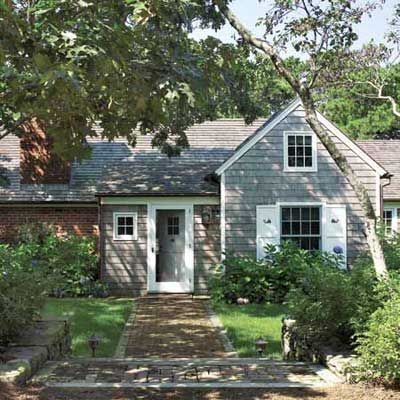
The equation seems simple: larger family equals larger house. The house
in question is a cottage in Amagansett, New York, in the dunelands of the East End of Long Island. Kevin Blaney purchased it as a weekend retreat when he was single and still courting his future wife, Liz. The house served them well, but a dozen years and four children later, “we had simply outgrown the place,” says Liz. Yet, “we loved the atmosphere of Scheffer homes—they’re so cozy and welcoming—and we wanted to keep that feeling.” (“Scheffer” is architect Alfred Scheffer, who helped turn the townships of the East End into the sought-after summer resorts now known as the Hamptons.) Keep reading to see how the Blaney family modified the house they loved to accommodate their growing family.
Shown: New shutters, roof, windows, and brick and cedar-shingle siding give the 1965 house a fresh look without altering its modest, seaside-cottage style. Inside, many little changes add up to major improvements in comfort and flow.
Smooth Transitions
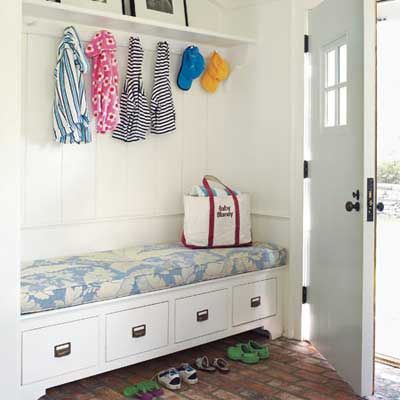
The Blaneys were lucky to find just the right partner for their project in architect Darren Helgesen, who knew and appreciated Scheffer’s work. “It was as important to me as it was to the clients to maintain the spirit of the house,” says Helgesen.
The renovation seemed straightforward enough. The Blaneys wanted to open up and expand the first floor by taking down walls and adding on to each side, one with a dining room and a breakfast area and the other with a master suite—both opening onto the refurbished back patio. They also asked Helgesen to open up the downstairs and to add a mudroom where kids could shed their dirty boots. Two patio upgrades were on their list as well: a new pool house with an outdoor shower, and a renovated shed where they could store barbecue equipment and outdoor tableware as well as garden tools.
Shown: The brick-floored mudroom, an addition, serves as a buffer between the house and garden, with a boot bench that doubles as storage for flip-flops.
Ready to Renovate
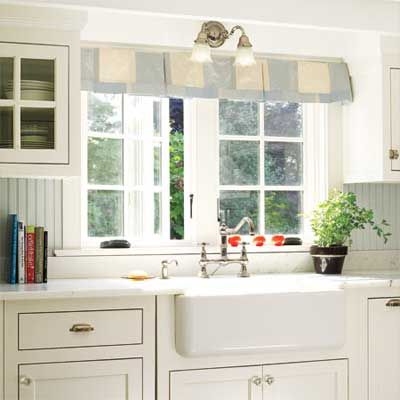
The Blaney house, which Scheffer built in 1965 for his daughter, was a variant on the Cape Cod type: a low-slung, two-story, gable-end main structure bisected by a shorter front-gabled section. With less than 1,650 square feet, it boasted five bedrooms but lacked a master suite and dining room, and the front door opened right into the living room. The house, with a pool and shed in back, exuded a quiet, reserved charm, and the Blaneys hoped to keep it that way; they wanted the place to be bigger but not look bigger. “To make it work,” says Liz, “the house just needed lots of little things.” But, there are “lots,” of course, and then there are “LOTS.”
Shown: The all-white kitchen reflects light pouring through new, storm-worthy windows.
Working Out the Kinks
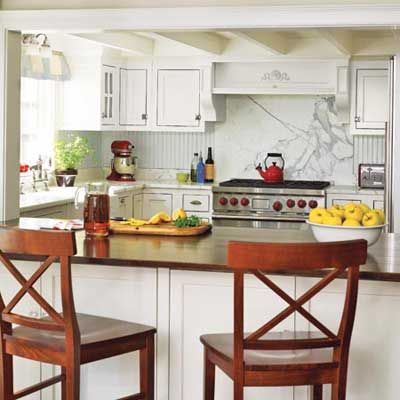
And, none of it was easy. “You can’t just slap up new walls,” says Helgesen, referring to opening up the house to graft on additions. “When you renovate an old house you have to take care of the basics first”—starting with the roof and foundation. Helgesen enlisted veteran contractor Marty Mahar, who also foresaw complications. Houses in this part of Amagansett, built from the 1940s to ’60s, “were meant to be used as summer places,” Mahar says. “When you start to work on one, you never know what you’ll find.” The kitchen was widened just 2 feet, but with white cabinets swapped in for the old cherry cupboards (which were reused in the garden shed) and the addition of white marble countertops and backsplash, the room appears twice its former size. Helgesen’s simple, clean-lined moldings and trimwork—all, like the beamed ceilings and walls, finished in white tones—contribute to the sense of spaciousness.
Shown: A custom mantel hides the range hood and gives cabinets a finished look. A wall came down to create room for a peninsula and open up
the kitchen to a new breakfast area. Marble counters, a pro-style range, and a walnut-stained top on the snack bar play off cottage-style beadboard and vintage-look cabinets with old-fashioned polished-nickel hardware.
A Series of Setbacks

Upon inspecting the underpinnings of the house, what Helgesen and Mahar found was rot caused by termites—”the bugs love the sandy soil,” says Mahar—as well as water damage. “The groundwater is so high in the dunes that there’s always dampness and constant risk of flooding,” says Helgesen, who for that reason planned to move the mechanicals to an attic space and install a sump-pump system and dehumidifiers in the basement.
The architect and builder made repairs, insect-proofed the old foundation, and built foundations for the additions. But Mother Nature seemed to have it in for them. The day after they poured one concrete slab, a low-pressure weather front blew in, followed by days and days of rain. “We tried pumping the water out of the basement, but the ground was so saturated, the water just washed back in,” says Mahar. “We couldn’t do anything for weeks.”
That was the biggest fiasco on the project, but hardly its biggest challenge.
Shown: The vaulted cottage ceiling adds volume to the dining room. After the original dining alcove was merged with the living room, an addition with a dining room and breakfast area was grafted on. White paint and French doors help give the 144-square-foot dining room its spacious feel.
Wonderful Windows
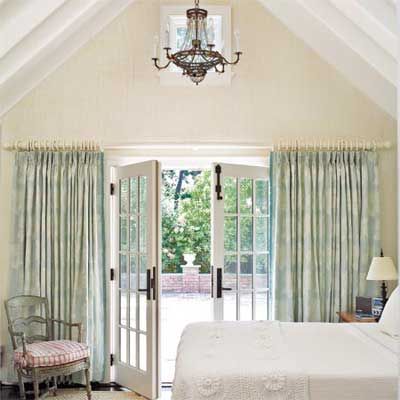
Helgesen had to design a new roof—enlarging beams, realigning exposed rafters, and reconfiguring trusses—to evenly distribute the roof’s weight over the new additions to the house. And then there was Amagansett’s recent adoption of a hurricane-zone standard requiring windows with high-impact glass.
And windows are among the chief delights of Helgesen’s design. The East End of Long Island is famous for its brilliant light, and Helgesen brought in as much as he could. He installed French doors in the new breakfast area and master suite, built out a box bay in the living room, and enlarged windows or added more where he could, thus employing one of his favorite tricks: “Whether you are walking down a hallway or entering a room, I want you to be moving toward a window,” he says. “It makes the space seem larger.” His choice of finishes enhances the effect.
Shown: The master bedroom’s 13-foot vaulted ceiling echoes the one over the dining room, which adds volume and reflects light.
Kiddie Corner
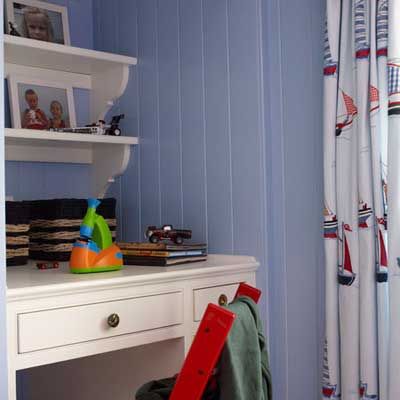
The most ingenious aspect of the renovation may be one of the subtlest: the use of built-ins throughout. A collaborative effort by the architect, homeowners, and contractor—who allows that cabinetry is his favorite part of most projects—the built-ins create discrete storage and work areas and reduce the need for furniture in smaller rooms, like the kids’ bedrooms.
Shown: Wall-mounted shelves and a desk make this corner in the kid’s bedroom a cozy corner for hitting the books.
Storage Solutions
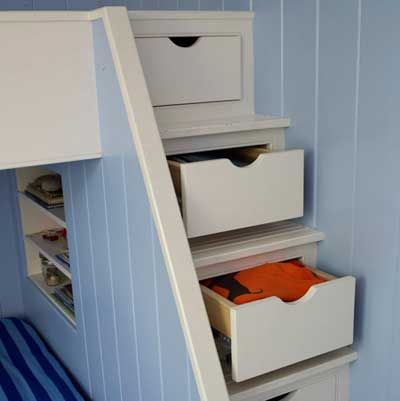
“None of the kids has to double up, and there’s plenty of room for sleepovers,” says Liz of the revised space. “It’s kind of wonderful how we managed to make the most of every space. It’s not a huge house, but now it feels perfect for us.”
Shown: At the foot of the bunk bed, built-in drawers and recessed shelves create fun and clever storage opportunities.
Design Tip: Room With a View
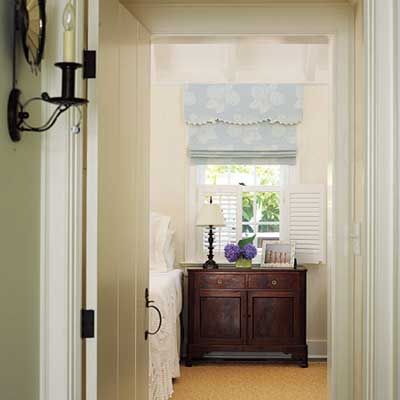
A clear sight line to the window connects the bedroom to the garden. The first floor’s new master bedroom suite has sunny windows and a set of French doors that bring in more light and double as a private entrance. Shutters can be closed for privacy, and Roman shades can be lowered to allow sleeping in.
Design Tip: Past Meets Present
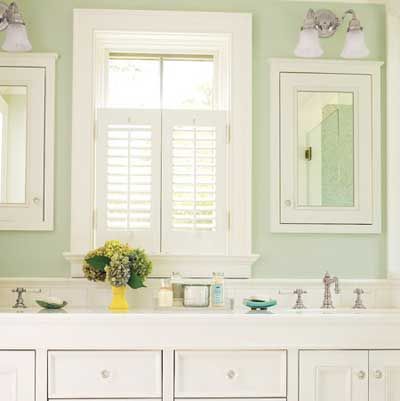
Vintage-style medicine cabinets, sconces, faucets, and floor tile give the new master bath its been-here-forever look. The capacious double vanity is a nod to the present.
The Perfect Patio
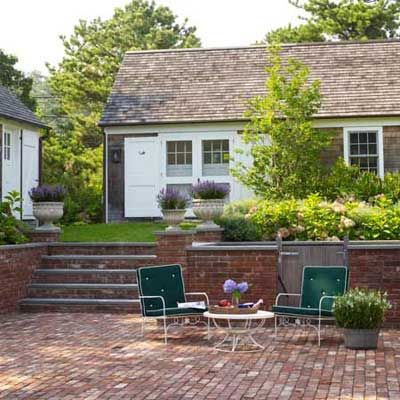
The backyard had long held a garden shed, which the architect refurbished to complement a new reclaimed-brick and bluestone patio and built-in barbecue.
Outdoor Kitchen
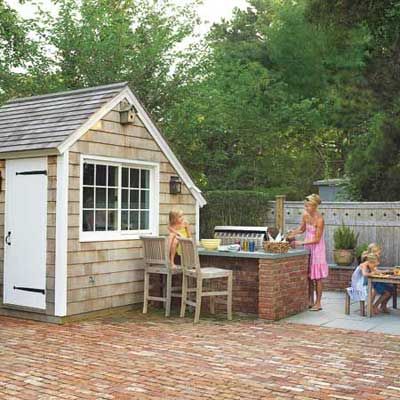
The oversize door and a birdhouse tucked in the gable reinforce the garden shed’s dollhouse proportions, echoed in a second shed added nearby, complete with a bath. The space also served the outdoor dining area: With plates, forks, and salt and pepper close at hand, there are fewer trips back and forth to the kitchen.
Outdoor Shower

The other side of the shed features a beautiful outdoor shower. The new pool house features clever built-ins—just like the main house—while echoing the existing garden shed’s cunning size and style.
Floor Plans
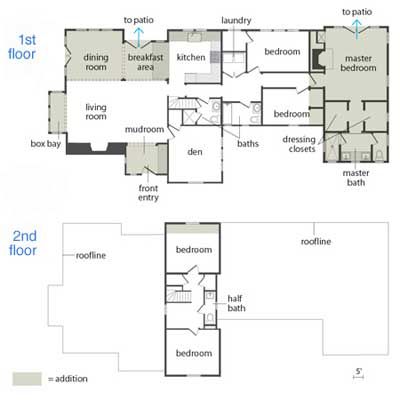
A series of first-floor additions enlarged the house to 2,545 square feet and opened up the living, dining, and cooking areas. The kitchen bump-out also added a bit of space to the bedroom above.
